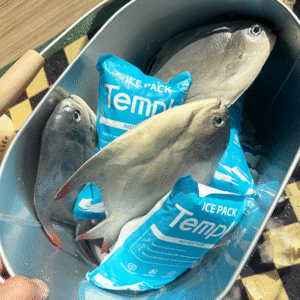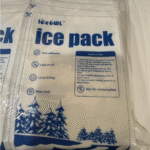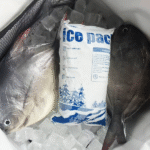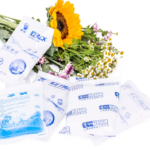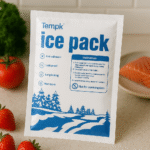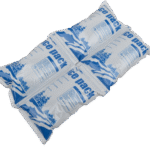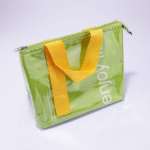Envasado de hielo seco y las láminas de hielo seco resuelven un desafío común de la cadena de frío: cómo mantener los productos congelados sin fugas ni ensuciar. El hielo seco es dióxido de carbono sólido que se sublima hasta convertirse en gas en lugar de fundirse y convertirse en líquido., haciéndolo ideal para enviar alimentos congelados, vacunas y muestras de laboratorio. Estas soluciones aisladas mantienen temperaturas ultrabajas y simplifican la limpieza.. Mientras planificas tus envíos, ¿Quieres saber cómo funciona el envasado con hielo seco?, ¿Qué diferencia las láminas de hielo seco de las de gel?, y cómo manipular estos materiales de forma segura. Esta guía combina el conocimiento de la industria con 2025 Mejores prácticas de SEO para mantener sus envíos y su sitio web en la cima.
¿Qué hace? empaquetado de hielo seco y Hojas de paquete de hielo seco herramientas esenciales para la cadena de frío?
¿Cómo se selecciona el derecho? empaquetado de hielo seco para alimentos, productos farmacéuticos y otros productos?
¿Qué pautas reglamentarias y de seguridad debes seguir al realizar envíos con hielo seco??
¿Cómo se pueden comparar las láminas de hielo seco con las de gel u otros refrigerantes??
¿Qué innovaciones y tendencias deberías observar en el envasado de cadena de frío en 2025?
¿Por qué elegir envases con hielo seco para el envío de productos perecederos??
El envasado con hielo seco proporciona una forma sencilla y fiable de mantener la carga extremadamente fría y al mismo tiempo evitar el desorden asociado con el hielo derretido.. El hielo seco no se derrite; se sublima directamente de un sólido a gas dióxido de carbono. Esto significa que los envíos permanecen secos., sin que se acumule agua en su caja o refrigerador. Cuando se usa correctamente, El embalaje con hielo seco mantiene temperaturas tan bajas como -109 °F (aproximadamente –78 °C) durante horas o incluso días, dependiendo del aislamiento.
¿Cómo funciona el envasado con hielo seco??
El envasado con hielo seco utiliza un recipiente aislado revestido con un material que permite que el gas de dióxido de carbono escape de forma segura.. El hielo seco del interior se sublima gradualmente., Absorber el calor de sus productos y mantener bajas temperaturas.. Los contenedores generalmente están hechos de espuma de poliestireno expandido (Espuma de poliestireno) colocado dentro de una caja de cartón corrugado. Este diseño de doble capa proporciona resistencia y aislamiento al tiempo que permite la ventilación..
En contraste, El hielo tradicional se derrite y crea agua líquida.; Los paquetes de gel absorben el calor y eventualmente se calientan.. Los envases con hielo seco mantienen los artículos bajo cero durante más tiempo, haciéndolo ideal para:
Alimentos congelados: mariscos, carne, helado, los kits de comida y los productos horneados especiales se benefician de temperaturas bajo cero durante el tránsito.
ciencias de la vida: vacunas, Las muestras de diagnóstico y los productos farmacéuticos a menudo requieren envío entre –70 °C y –20 °C..
Aplicaciones industriales: Envío de materiales biológicos o reactivos de laboratorio que deben permanecer congelados..
¿Qué son las láminas de bolsas de hielo seco y en qué se diferencian de las bolsas de gel??
Las láminas de hielo seco son láminas flexibles que contienen bolsas de hielo seco o compuesto de hielo seco.. Ofrecen beneficios similares al hielo seco suelto pero son más fáciles de manejar.. El El diseño laminado reduce el contacto directo con la piel., que ayuda a prevenir la congelación, y simplifica el embalaje porque se puede cortar la hoja a medida.
Los paquetes de gel son paquetes reutilizables a base de polímeros llenos de agua u otro gel refrescante.. Mantienen temperaturas alrededor 0 °C y calentar gradualmente a temperatura ambiente. A diferencia de los paquetes de gel, Las láminas de hielo seco mantienen temperaturas bajo cero y no producen subproductos líquidos.. Son adecuados para envíos que requieren condiciones extremadamente frías durante períodos más cortos o donde el espacio es limitado..
Elegir el embalaje adecuado: Factores clave
Requisitos de temperatura y tipo de producto: Conozca el rango de temperatura crítico para su producto. Por ejemplo, las vacunas enviadas en hielo seco pueden requerir –70 °C, mientras que la repostería gourmet puede que solo necesite permanecer por debajo de –18 °C. Los envases y hojas de hielo seco están diseñados para temperaturas ultrabajas o bajas de congelación., mientras que los paquetes de gel cubren las cocinas refrigeradas.
Tiempo de tránsito: Calcule cuánto tiempo estará en tránsito el envío.. El hielo seco se sublima con el tiempo; planificar la cantidad para que dure todo el viaje más un margen.
Regulaciones: El hielo seco es un material peligroso clasificado como Clase 9 bien peligroso con la ONU 1845. Debes cumplir con las normas de envío, incluido el etiquetado., embalaje y documentación.
Presupuesto y sostenibilidad: Considere el costo por envío, Eliminación de residuos e impacto ambiental.. El hielo seco se fabrica a partir de dióxido de carbono recuperado., pero la fabricación y el embalaje producen emisiones. Los paquetes de gel reutilizables pueden ser más económicos para envíos frecuentes a temperaturas moderadas.
¿Qué pautas reglamentarias y de seguridad debe seguir??
El envío de hielo seco requiere conocimiento de las regulaciones y manejo seguro para proteger a los trabajadores., transportistas y destinatarios. Los EE. UU.. Departamento de Transporte (PUNTO) y la Asociación Internacional de Transporte Aéreo (IATA) establecer pautas estrictas para el embalaje, etiquetado y documentación.
Clasificación de peligros y formación
El hielo seco está clasificado como Clase 9 mercancías peligrosas diversas. Su nombre de envío correcto es “Hielo seco” o “Dióxido de carbono, sólido,” y su número de identificación de la ONU es Y 1845. Los empleados que manipulen paquetes de hielo seco deben recibir materiales peligrosos. (patria) formación para garantizar que comprendan los riesgos y procedimientos.
Los envíos de hielo seco están regulados porque:
Crear presión: Mientras el hielo seco se sublima, El gas dióxido de carbono se acumula.. Los contenedores deben permitir que el gas se ventile.; de lo contrario, podrían explotar.
Desplazar el oxígeno: El dióxido de carbono es más pesado que el aire y puede acumularse en espacios reducidos., presentando un peligro de asfixia. Asegúrese de que haya ventilación durante el almacenamiento y el transporte..
Causa quemaduras por frio: El hielo seco se encuentra a alrededor de -109 °F. El contacto con la piel puede provocar congelación..
Requisitos de embalaje
Etiquetado y marcado: Los paquetes deben mostrar el nombre de envío correcto., Número de la ONU, la clase 9 etiqueta de peligro, y el peso neto del hielo seco en kilogramos. Cada paquete debe estar claramente marcado con las direcciones del remitente y del destinatario e incluir una declaración de que se liberará gas dióxido de carbono..
Límites de peso: Para transporte aéreo, El peso neto de hielo seco por paquete a menudo se limita a 200 kilos (consulte con su operador para conocer los límites específicos). Demasiado hielo seco puede crear una presión excesiva.
Documentación: Una carta de porte aéreo o factura comercial debe incluir el número ONU, número de paquetes y peso neto. Al realizar envíos internacionales, Incluir permisos de importación/exportación y otra documentación requerida..
Materiales de embalaje: El embalaje exterior debe ser duradero y a prueba de fugas. Utilice tableros de fibra o cajas de madera con aislamiento como poliestireno expandido. Evite recipientes sellados o materiales que se vuelvan quebradizos a bajas temperaturas..
Ventilación: El paquete debe permitir que el gas dióxido de carbono escape para evitar el aumento de presión.. Esto a menudo significa dejar un pequeño respiradero o usar contenedores diseñados para ventilar gradualmente..
Consejos de seguridad y manejo
Equipo de protección personal: Use guantes aislados, gafas y protección facial al manipular hielo seco. Utilice pinzas o herramientas para evitar el contacto directo..
Ventilación: Trabaje en un área bien ventilada para evitar la acumulación de dióxido de carbono.. No utilice hielo seco en espacios reducidos como maleteros de automóviles sin ventilación..
Almacenamiento: Guarde el hielo seco en contenedores aislados pero no los selles; Los contenedores sellados pueden explotar.. Mantener alejado de los niños y las mascotas..
Desecho: Deje que el hielo seco sobrante se sublime en un recipiente abierto., área ventilada. Nunca deseche el hielo seco en los lavabos, baños o contenedores de basura.
Primeros auxilios: Trate la congelación causada por hielo seco como una quemadura: caliente el área con agua tibia y busque atención médica si es necesario..
Seguir estas pautas lo protege y garantiza que sus envíos cumplan con los requisitos reglamentarios..
Comparación de láminas de hielo seco con otras soluciones de refrigeración
| Solución de enfriamiento | Rango de temperatura | Duración típica | Residuo líquido | Aplicaciones prácticas |
| Hojas de hielo seco | –109 °F a –20 °F (aprox.) | 24–48 horas (Depende del espesor y del aislamiento.) | No | Envíos ultracongelados, paquetes con espacio limitado |
| Bolitas de hielo seco sueltas | –109 °F a –20 °F | 24–72 horas | No | Envíos a granel, duraciones más largas |
| paquetes de gel | 32 °F a 41 °F | 12–48 horas | Sí (cuando se descongela) | Productos farmacéuticos que requieren condiciones de refrigeración., alimentos perecederos |
| Packs de materiales de cambio de fase | Costumbre (varía de –5 °F a 20 °F) | 24–96 horas | Mínimo | Biológicos, envíos con control preciso de temperatura |
Ventajas de las láminas de hielo seco
Ajuste preciso: Se pueden cortar o doblar para que coincidan con la forma de su paquete., Reducir el espacio vacío y garantizar una refrigeración uniforme..
Manejo limpio: El hielo seco encerrado reduce el contacto directo y el riesgo de congelación.
Riesgo reducido de explosión.: La mayoría de las láminas incorporan microperforaciones o canales de ventilación para liberar el gas lentamente..
Eficiencia espacial: Las láminas ocupan menos volumen que los gránulos de hielo seco sueltos..
Experiencia de usuario mejorada: Los destinatarios pueden deshacerse de la sábana fácilmente; simplemente déjela en un área ventilada para sublimarla..
Cuándo utilizar paquetes de gel en su lugar
Los paquetes de gel son mejores para envíos que necesitan un refrigerador. (no congelado) temperatura. Son reutilizables, más fácil de almacenar y manipular, y plantean menos desafíos regulatorios porque no están clasificados como mercancías peligrosas. Úsalos para productos como fruta fresca., queso, o comidas preparadas que requieren temperaturas superiores al punto de congelación. Para envíos ultrafríos, sin embargo, El embalaje con hielo seco y las láminas para bolsas de hielo seco siguen siendo la opción preferida..
Materiales de embalaje y estrategias de diseño innovadores
Materiales de aislamiento
Los envases tradicionales de hielo seco se basan en poliestireno expandido (EPS) espuma. Si bien es efectivo, El EPS no es biodegradable y puede ser difícil de reciclar.. Están surgiendo nuevos materiales:
Paneles aislados de vacío (VIP): Paneles delgados con conductividad térmica extremadamente baja.. Proporcionan un aislamiento fuerte en un espacio más pequeño, pero pueden ser costosos..
Aislamiento a base de papel: Algunas empresas utilizan cartón ondulado combinado con papel aislante elaborado con fibras recicladas.. Estas soluciones son compostables y reducen los residuos..
Espuma biodegradable: Espumas de origen vegetal (p.ej., espuma de maicena) que proporcionan un aislamiento comparable al EPS pero se descomponen más fácilmente en entornos de compostaje.
Agentes refrigerantes sostenibles
Dióxido de carbono sólido procedente de fuentes renovables: Algunos fabricantes capturan CO₂ de biomasa o procesos industriales para fabricar hielo seco, reduciendo la huella de carbono.
Materiales de cambio de fase a base de agua.: Envasado en plásticos de origen vegetal., Estos PCM mantienen temperaturas estables alrededor 0 °C sin utilizar geles a base de petróleo.
Diseño de packaging para comercio electrónico
El auge del comercio electrónico ha aumentado la demanda de pequeñas empresas., Embalaje liviano que cabe en los casilleros para paquetes.. Las láminas de hielo seco ayudan a reducir las dimensiones y el peso del paquete. Algunos diseños incluyen compartimentos separados para comida y hielo seco, evitando el contacto directo y permitiendo a los consumidores retirar la capa de hielo seco fácilmente en el momento de la entrega.
Sensores inteligentes e integración de IoT
Las empresas están incorporando sensores de temperatura y registradores de datos dentro de los envíos. Estos dispositivos registran la temperatura y la humedad durante el tránsito y transmiten datos a través de redes celulares o Bluetooth.. Los remitentes y destinatarios pueden verificar que el producto se mantuvo dentro del rango de temperatura requerido. En 2025, espere que se incluyan más envases Comunicación de campo cercano (NFC) etiquetas o códigos QR que permiten a los clientes verificar el historial de envíos en un teléfono inteligente.
2025 Tendencias e innovaciones en envases de hielo seco
El sector de la cadena de frío continúa evolucionando a medida que crece la demanda de entrega de productos perecederos por parte de los consumidores y aumentan las preocupaciones sobre la sostenibilidad.. A continuación se muestran algunas tendencias que están dando forma 2025:
Crecimiento de los alimentos congelados directos al consumidor
Los servicios de comestibles y kits de comida en línea aumentaron durante la pandemia de COVID-19 y continúan creciendo. Los consumidores esperan que les entreguen comidas congeladas con calidad de restaurante en la puerta de sus casas.. El envasado con hielo seco garantiza que los productos permanezcan congelados durante la entrega de última milla. Las empresas están invirtiendo en hojas compactas de hielo seco y mejor aislamiento para reducir los costos de envío.
Iniciativas de embalaje sostenible
Las regulaciones y las preferencias de los consumidores empujan a las empresas a reducir los residuos y las emisiones de carbono. espera ver embalaje híbrido combinando hielo seco con aislamiento biodegradable y cajas exteriores reutilizables. Algunas nuevas empresas ofrecen programas de suscripción en los que los clientes devuelven contenedores aislados para su reutilización..
Mejora de la seguridad y automatización de los trabajadores
Robots y sistemas automatizados manejan el envasado de hielo seco en grandes centros logísticos, reducir la exposición humana al frío extremo. Los programas de capacitación se centran en el reconocimiento de peligros y el uso adecuado de equipos de protección personal.. La tecnología portátil monitorea los niveles de CO₂ y advierte a los empleados si la ventilación es insuficiente.
Integración con la logística de almacenamiento en frío
El envasado con hielo seco forma parte de una red más amplia de cadena de frío. Uso de almacenes y centros de distribución. congeladores de temperatura ultrabaja y sistemas de recogida automatizados para mantener los productos congelados hasta su embalaje.. Proveedores de logística de terceros (3PL) ofrecer servicios especializados de cadena de frío, Combinando envíos de hielo seco con vehículos con temperatura controlada..
Cambios regulatorios
Las reglas de envío internacional pueden cambiar, especialmente después de las lecciones de la pandemia. Hay un impulso para estandarizar la documentación y la capacitación en todos los países., y los transportistas están implementando documentación digital para agilizar el cumplimiento. Esté atento a las actualizaciones de IATA y el Organización de Aviación Civil Internacional (OACI) que pueden afectar el envío de hielo seco.
Preguntas frecuentes
Q1: ¿Cuánto hielo seco debo utilizar para un envío de 24 horas??
La cantidad depende del tamaño del contenedor., aislamiento y temperatura exterior. Una pauta común es de 5 a 10 libras (2–4.5 kg) de hielo seco por período de 24 horas para una hielera pequeña. Use más para paquetes más grandes o climas más cálidos. Comience con una prueba para encontrar la cantidad correcta.
Q2: ¿Puedo poner hielo seco en una caja de cartón normal??
El cartón por sí solo no es suficiente; necesita una capa aislante como espuma EPS para ralentizar la sublimación. Coloque el enfriador de espuma dentro de la caja de cartón y cúbralo con láminas o bolitas de hielo seco.. Deje un espacio para la ventilación..
Q3: ¿Es seguro enviar hielo seco con alimentos??
Sí, El hielo seco es apto para uso alimentario y se utiliza habitualmente para enviar alimentos congelados.. Mantenga el hielo seco separado de los alimentos mediante el uso de una barrera. (p.ej., papel o cartón) para evitar el contacto directo.
Q4: ¿Cuánto dura una lámina de hielo seco??
Una lámina típica puede mantener temperaturas bajo cero hasta por 24 a 48 horas., dependiendo del espesor, temperatura ambiente y aislamiento. Para tiempos de envío más largos, use varias hojas o combínelas con hielo seco suelto.
Q5: ¿Se pueden reutilizar las láminas de hielo seco??
A diferencia de los paquetes de gel, Las capas de hielo seco no se pueden reutilizar porque el hielo seco se sublima.. Sin embargo, Algunas láminas se pueden eliminar con la basura doméstica normal después de que el hielo seco se haya sublimado..
Q6: ¿El envío con hielo seco daña el medio ambiente??
El propio hielo seco se fabrica a partir de CO₂ capturado en otros procesos., para que no genere CO₂ adicional. Sin embargo, La fabricación del producto de embalaje y envío contribuye a las emisiones.. Elegir materiales biodegradables y optimizar el tamaño de los envíos ayuda a reducir el impacto ambiental.
Sugerencias de enlaces internos
Para mejorar la experiencia del usuario y el SEO, vincular esta guía a contenido relacionado en su sitio:
Mejores prácticas de cadena de frío para productos perecederos – una descripción general completa del embalaje, envío y recepción de artículos congelados.
Elegir los paquetes de gel adecuados para el envío refrigerado – directrices para envíos que no requieren temperaturas ultrabajas.
Dispositivos de control de temperatura – una introducción a los registradores de datos, Etiquetas NFC y sensores IoT en la logística de la cadena de frío.
Soluciones de embalaje sostenibles – explorar materiales ecológicos y estrategias para reducir los residuos en la cadena de frío.
Lista de verificación de cumplimiento normativo para materiales peligrosos – una lista de verificación para el etiquetado, Documentación y capacitación al realizar envíos con hielo seco y otros materiales peligrosos..
Consejos prácticos y sugerencias prácticas
Para viajes cortos (24 horas): Utilice una hoja compacta de hielo seco con 2 a 3 libras (1–1,5 kilos) de hielo seco. Envuelva su producto en periódico para evitar el contacto directo..
Para viajes largos: Combine hojas de paquete con bolitas de hielo seco sueltas. Coloque los gránulos en el fondo del recipiente y coloque la hoja encima para asegurar un enfriamiento uniforme..
Para mercancías extremadamente sensibles: Coloque un termómetro o registrador de datos dentro del paquete para monitorear la temperatura e identificar cualquier desviación.. Utilice aislamiento VIP si es necesario.
Planifique la entrega de última milla: Trabaje con transportistas que ofrezcan servicios de última milla con temperatura controlada o coordine con los clientes para garantizar el desembalaje inmediato a su llegada..
Comunicarse con sus destinatarios: Incluya instrucciones en su paquete sobre el manejo del hielo seco., deshacerse de la hoja, y almacenar el producto a su llegada.
Ejemplo del mundo real: Una pequeña empresa de productos del mar de Alaska envía fletán congelado a clientes de California. se utiliza dos láminas de hielo seco y cinco libras de hielo seco suelto en un refrigerador de EPS dentro de una caja de cartón. El envío viaja por vía aérea y terrestre por 30 horas. Gracias a la combinación de láminas y pellets, el pescado llega congelado. La empresa adjunta una nota instruyendo a los clientes a utilizar guantes para retirar la lámina y dejarla sublimar al aire libre..
Perspectivas de mercado para 2025
Según análisis de la industria, Se espera que el mercado mundial de envases de cadena de frío crezca a una tasa de crecimiento anual compuesta. (Tocón) de alrededor 14% a través de 2025. Los factores que impulsan el crecimiento incluyen la expansión de los servicios de comestibles en línea., Creciente demanda de productos biológicos y medicina personalizada., y normas de seguridad alimentaria más estrictas. Hay un cambio hacia ligero, materiales reciclables y modelos de embalaje como servicio, donde las empresas alquilan contenedores reutilizables.
Tanto los consumidores como los reguladores otorgan mayor valor a la transparencia y la sostenibilidad. Los clientes conocedores de las redes sociales exigen pruebas de que sus comidas congeladas se envían de manera responsable. Como resultado, Los diseños de empaque incorporan códigos QR que conducen a páginas que explican los materiales de empaque., Instrucciones de eliminación y huella de carbono.. Las marcas que adopten tempranamente envases sostenibles de hielo seco pueden obtener una ventaja competitiva.
Conclusión y próximos pasos
Los envases con hielo seco y las láminas para paquetes de hielo seco son herramientas poderosas para mantener los productos congelados durante el envío.. Las propiedades de sublimación del hielo seco previenen la suciedad y mantienen temperaturas extremadamente bajas., mientras que los formatos en láminas aportan comodidad y seguridad. Para utilizar estas soluciones de forma eficaz, Siga las pautas regulatorias, Maneje el hielo seco de forma segura y elija los materiales de embalaje adecuados para su producto y presupuesto..
Mientras preparas tus envíos, Considere realizar pruebas para determinar la cantidad ideal de hielo seco y la configuración de la hoja de embalaje.. Invierta en aislamiento de calidad, incorporar monitoreo de temperatura y mantenerse al día con las tendencias emergentes como materiales biodegradables y sensores inteligentes. Manténgase informado sobre la evolución de las regulaciones, y eduque a su equipo para garantizar el cumplimiento. Adoptando estas prácticas, protegerás tus productos, satisfacer a los clientes y mantener una ventaja competitiva en la creciente industria de la cadena de frío.
Acerca de TempK
y tempk, Nos especializamos en soluciones innovadoras de cadena de frío. que ayudan a las empresas a enviar productos sensibles a la temperatura de forma segura y sostenible. Nuestra gama de productos incluye envases de hielo seco., Hojas de paquete de hielo seco, paquetes de gel, sensores de temperatura y contenedores isotérmicos diseñados a medida. Aprovechamos décadas de experiencia en logística y ciencia de materiales para ofrecer soluciones adaptadas a sus necesidades.. Nuestro compromiso con la calidad y la sostenibilidad significa que invertimos continuamente en R&D para desarrollar Materiales ecológicos y opciones de embalaje más inteligentes..
Llamado a la acción
Listo para optimizar sus operaciones de cadena de frío? Póngase en contacto con TempK para una consulta personalizada y explore nuestra gama de soluciones de envasado de hielo seco. Nuestros expertos pueden ayudarle a elegir la combinación adecuada de hojas de embalaje., Herramientas de aislamiento y monitoreo para mantener sus envíos seguros y conformes.. Comuníquese hoy para comenzar a realizar envíos con confianza.






